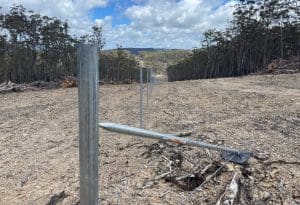SOME of the finest wool growing country in the nation will soon benefit from protection from wild dog predation once the Moona-Winterbourne exclusion fence is completed.
The project has delivered a 44km predator proof fence in the Walcha region of northern NSW, directly protecting 110,000ha of livestock production owned by 150 landholders and aid on-farm biodiversity in the New England.

: the Moona-Winterbourne fence complemented an existing 67km of non-continuous fence exclusion fencing on property boundaries following the 2020-2021 bushfires.
The fence was started in July 2020 with local contractors, materials and labour used to inject vital funds into drought and fire recovery, while project management was provided in-kind by Australian Wool Innovation, Local Land Services, NSW Department of Primary Industries, National Parks and Wildlife and landowners.
Walcha Council secured $986,800 in round 2 of the Federal Government’s Communities Combating Pest and Weed Impacts During Drought Program – Biosecurity Management of Pests and Weeds.
AWI North East NSW wild dog management coordinator David Worsley led the project’s scoping and stakeholder consultation activities, and said wet weather in 2022 had delayed the build completion.
Mr Worsley said the exclusion fence would give landholders the opportunity to run sheep.
He said the whole regional community would benefit from the flow on effects with a $5 return for every $1 invested in the fence.
Mr Worsley said wild dog activity north of the existing fence had been constant and the fence’s completion would be a relief from the psychological stress for landholders dealing with wild dogs.
“The fence is another tool in the tool kit and it’s up to the landholders to continue with their baiting and trapping, and fence maintenance – a well maintained fence is a powerful tool.
“It gives us the ability to target wild dogs tracking along the fence so we can be much more strategic in our control.”
National Wild Dog Management Coordinator Greg Mifsud said the Moona-Winterbourne fence complemented an existing 67km of non-continuous exclusion fencing on property boundaries following the 2020-2021 bushfires.
“This provides 111km of exclusion fencing along the escarpment protecting sheep grazing properties from wild dogs which consistently disperse from the extensive public lands from the coast to the escarpment,” Mr Mifsud said.
“There are 11 properties on the newly erected section of fence but the combined 111km of fence will offer protection from wild dog incursions over a much larger area of the northern Tablelands.”
 Walcha property manager Tony Overton has experienced stock losses over the past two decades to wild dogs and was a driver behind the Moona-Winterbourne exclusion fence concept.
Walcha property manager Tony Overton has experienced stock losses over the past two decades to wild dogs and was a driver behind the Moona-Winterbourne exclusion fence concept.
Mr Overton said the exclusion fence was a good model for going forward in the high production country, giving producers options to diversify into small stock.
He said the benefits would include reduced grazing pressure by kangaroos, increased biodiversity and the generation of employment for locals.
“We now have this fantastic asset for the community. Having someone checking the fence regularly and keeping that track open – it gives us eyes on the ground for pressure on the fence and an accessible fire trail.
“It’s not a single fix, we still need other strategies, trappers and baiting programs as the dogs are hard on native animals. It’s good for agriculture, the environment and stops weeds and pests.”
Walcha Shire Council Mayor Eric Noakes paid tribute to David Worsley, Australian Wool Innovation and Local Land Services for their contribution to the project.
Cr Noakes, a wool grower and beef producer, said the social and economic benefits for Walcha would include short- and long-term employment, and enterprise opportunities and livestock protection for landholders.
He has empathy with the shire’s farmers experiencing the psychological stress from livestock attacks.
“There has been a step back from running sheep, whether that is labour availability or wild dog predation,” he said.
“Anecdotally, Walcha grows some of the best fine wool in the world, the shearing season was long and local businesses benefited from it. It is missed as once all the country around Walcha ran sheep, with the shearing teams providing an economic benefit.
Going forward, Cr Noakes said ongoing maintenance was critical to ensure the success of the fence.
Source: National Wild Dog Action Plan

HAVE YOUR SAY